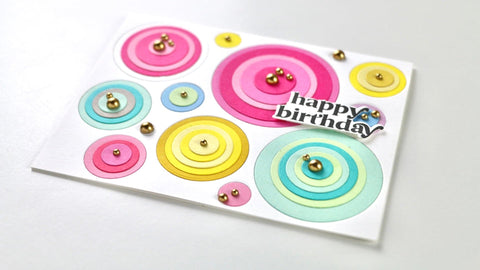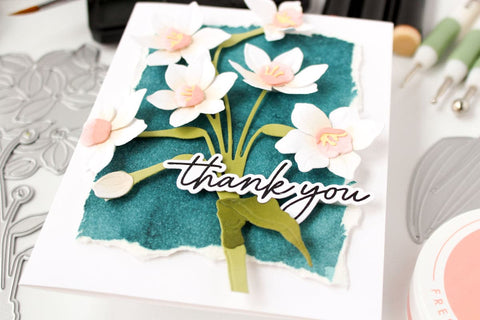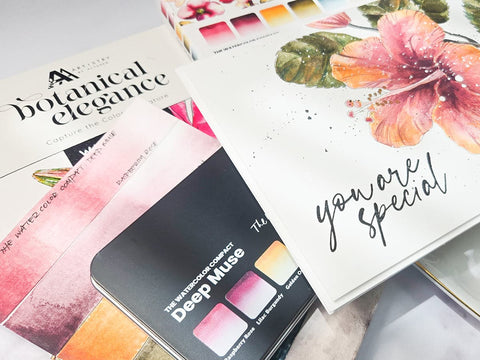What is Hot Foiling? A Quick Guide + Do’s and Don'ts
Last Updated: March 14, 2025
Hot foiling is a popular way to add metallic shine and dimension to paper crafting projects. It's an easy technique, but there are some things you should know before diving in! This post will explore everything hot foil-related, especially in paper crafting. We'll walk you through the materials and tools needed, how to prep your project, a few types of hot foil plates, and some tips for getting that perfect foiled finish. It's a quick guide, but it should give you enough information to get started on your next handmade project!

Handmade cards made with hot foiling
What Is Hot Foiling?
Hot foiling is a process that involves creating an impression on a surface using thin metal hot foil plates and special foil sheets (no, not that aluminum foil used for cooking!). The combination of heat (from the hot foil machine) and pressure (from the die-cutting machine) helps create a beautiful, shiny, metallic design. If you are familiar with the idea of creating a letterpress design, then you’re already halfway through understanding how this method works. It’s like a letterpress design but with a more luxurious shine and shimmer, thanks to the heat foil paper.

Gilded Rose Hot Foil Plate & Layering Stencil Bundle
How Does Hot Foiling Work?
Before you go and foil everything, you need to understand how hot foil plates work. Have you ever tried creating a customized t-shirt using a heating iron and some heat transfer paper? Hot foiling on paper or cardstock works pretty much the same way, but with different supplies.
A hot foil machine heats the hot foil die plate so this can transfer the image or design onto a surface. The shiny pigment from the thin hot foil sheet adds that much-needed metallic color to the plate’s design as it gets impressed onto the surface of cardstock, paper, or fabric. A die-cutting machine is needed to add more pressure. Running the hot foil platform a couple of times through a die-cut machine helps push the plate’s design into the surface more. This will ensure that the whole design gets transferred without any missing spots.
Hot Foil Supplies
Now that you have a basic understanding of how hot foiling works and how to use hot foil plates let’s take a quick look at some of the essential tools needed for this fun technique!
Hot foil plates
If you have been crafting for a while now, you’ll find that these look like your regular wafer-thin metal dies. The difference is that these are thin metals with etched areas that will allow you to press your foil into the paper instead of cutting a shape out of it (like metal dies). There’s a variety of sizes, designs, shapes, and patterns available out there. For your convenience, we have released hot foil die plates that coordinate with stamps, metal dies, and even stencils! Browse them here!

Hot foil machine
As the name suggests, this machine creates a metallic foiled effect on a surface. It comes with a base that is like a docking station. This docking station is where you put the hot foil plate platform to let it heat up. The platform is a removable part with a handle, often referred to as the “hot plate.” There is a gray area in the middle of the platform that is silicone-based; this is the area that gets hot. It has grid lines for proper placement. The lights on the machine indicate whether it is turned on, ready for use, and there’s a button for the timer. Most machines come with accessories, which we will discuss below.
Hot foil sheets or rolls
You can’t make pretty hot foiled designs without these! Hot foil sheets are available in various sizes and colors, with gold being the most popular. These ink-resistant sheets can be metallic, holographic, or iridescent. Each sheet has a metallic and shiny side. Some hot foil machines come with a couple of rolls that you can use for practicing.
PRO TIP! There are different types of foil so remember to get a heat foil roll for your hot foil machine. A deco foil (for laminating), reactive transfer foil, or adhesive foil won’t really work for this technique.

Eucalyptus Wreath Hot Foil Plate & Stencil Bundle
Tweezers
You can use regular crafting tweezers or stick to the special hot foil tweezers with magnets on them (these usually come with the machine). A good pair of tweezers will help you move or pick up the hot foil die plates while they’re on the hot plate so you won’t burn yourself.
Acrylic spacer plate
This is a clear acrylic plate that comes with most machines but can be bought as an additional accessory. It helps create your foiling sandwich and adds extra pressure onto the plate and paper, just like how die-cutting plates work.
Shim
This is usually made of plastic, acrylic, or metal, depending on which machine you use. Like the spacer plate, it is an integral part of your foiling sandwich.
PRO TIP! If your plate has a more intricate design, you can use a piece of cardstock as an additional shim!
Silicone cooling pad
This silicone pad comes with most machines. It is an optional accessory. Some crafters like using it; others say they can do without it. It is simply a silicone-based pad where you can set your hot foil plates on to cool off. It takes about 5 minutes for the plates to cool down completely.

When Should We Use Hot Foiling?
Now that you have an idea of how to hot foil, the next step is to find out when to use this handy little tool! We’ve listed a few ideas here!
- Create a quick background on your handmade cards.
- Use hot foiling to add a metallic and shiny element to your scrapbook page. Check out Lilith’s layout inspiration here.
- Impress your family and friends with some foiled DIY gift tags!
- Use simple geometric plate designs for masculine and neutral feel on your memory-keeping journal like what Nathalie did here.
- Personalize your bookmark and make them glimmer with some foiling.
- Create hot foil wedding invitations (or any kind of invitation!).
- Make your bullet journal shine by adding a foiled focal point or element.
- Add metallic vibes to your DIY home decor using your favorite hot foil sheets!

All Kinds of Amazing Hot Foil Plate
How to Hot Foil: Step by Step Process
- Turn on your hot foil machine to warm it up.
- Cut your foil sheet a bit bigger than your hot foil plate.
- Trim around the foil and make sure to remove sharp edges or corners.
- Once the green button on your machine turns on, place the plate on the platform with the “pretty side” up. Make sure it is warm enough!
- Place the foil, shiny side down, on top of the plate.
- Place your cardstock (or whatever material you’re using) on top of the foil.
- Then, place the thin shim and the acrylic spacer plate on top of the cardstock.
- Next, press the timer button. It takes about a minute for the timer to stop blinking.
- Once it stops blinking, remove the hot plate from the docking station and feed it to your die-cutting machine. Go forward and back a few times.
FUN FACT! Why do we need a die-cut machine? The hot foil machine only provides the heat; a die-cut machine would provide the necessary pressure to transfer the design onto the paper.
- Place the hot plate back on the docking station.
- Carefully remove the shims and the cardstock.
- Slowly peel the foil off your paper.

Hot foiling and ink blending on a handmade card
Hot Foiling Tips, Dos and Don’ts!
Learning how to hot foil is only half the battle. You need a few hacks and reminders to make this technique work and get the desired results.
- Trim the foil around your hot foil plate’s shape and cut as closely as possible. This will ensure that you don’t have excess foil outside your design.
- Remember, less excess foil, better results!
- Make sure to cut out sharp corners too.
- Always use a pair of tweezers to move the plates around and pick them up, so you don’t burn yourself. It might be tempting to just pick them up with your fingers, but that’s what the tweezers are for.
- When using a manual die-cut machine, make sure to crank it slowly to get better foiling results.
- Do not throw away the user manual. You will need to refer to it every now and then, especially when exploring other techniques.
- Use a sand eraser to remove the excess foil on your cardstock. A regular eraser might work too, but Jennifer McGuire highly recommends a sand eraser.
- Heat and pressure are crucial in hot foiling! Always make sure that your hot plate has enough heat, especially if you want to foil on textured surfaces (like colored cardstock).
- Do you feel a bit adventurous? Try using your plate as an embossing folder to add a raised dimension or a faux letterpress design on your handmade card!
- Die-cut the foiled designs! We’ve released a few hot foil die plates with coordinating dies to make it easier for you to add dimension to your projects.
- Speaking of dies, did you know that you can use your stand-alone dies for hot foiling? You just need to add an extra shim (like a cardstock) to ensure that your metal die won’t cut out the shape.
- Foil can resist ink, so you can stamp or ink blend over your foiled designs!
- This one goes without saying, but make sure your hot foil machine is compatible with your die-cut machine. You can always do your research online or ask the manufacturer for a list of compatible die-cut machines.
- Not all wafer-thin metal dies work with foiling machines, but you can give them a try. There’s no harm in trying.
- Over foiling or excess foiling is sometimes unavoidable, but a trick that some crafters swear by is using anti-static powder all over your cardstock before doing foiling. This is a great way to prepare your cardstock.

Are You Ready to Hot Foil?
We hope you've learned a lot from the hot foiling dos and don'ts we shared in this blog post. Did you find them helpful? Next time you're looking to add a little sparkle or shine to your DIY projects without having to clean up messy embossing powders, try doing some hot foil techniques instead! As always, check out our All About Crafting page for more project inspirations and ideas!
5 comments
In This Article
More Crafty Reads & Inspirations
-

Starting 2026 With a Clean Slate and Using Up Leftovers
-

January 2026 Inspiration Challenge
-

Simple Tips To Bring Your Die Cut Florals To Life - A Touch of Sparkle With Carissa Wiley
-

3 Secrets for No-Outline Watercoloring: The Art of the Disappearing Line | Perfect Pairings with Jaycee
-

Card Ideas that Symbolize New Beginnings
















Hello Jan! Yes, you can use a standalone die with hot foiling techniques! You can use a cardstock shim to prevent the die from cutting through, but kindly note that results may vary depending on your machine or technique. Feel free to experiment and check out our videos on YouTube on hot foiling with dies. Thank you!
11 Speaking of dies, did you know that you can use your stand-alone dies for hot foiling? You just need to add an extra shim (like a cardstock) to ensure that your metal die won’t cut out the shape.
Maggie asked:
“Question… When using a standard die to foil, where do you put the extra cardstock shim? I know it is a silly question, however, it always cuts through when I do it. Any tips?”
You don’t use standard dies to hot foil. You have to use dies specially made for hot foiling. They do not cut through the paper. They imprint and push the foil into the paper.
Thank you. This was very informative and well explained
Question… When using a standard die to foil, where do you put the extra cardstock shim? I know it is a silly question, however, it always cuts through when I do it. Any tips?